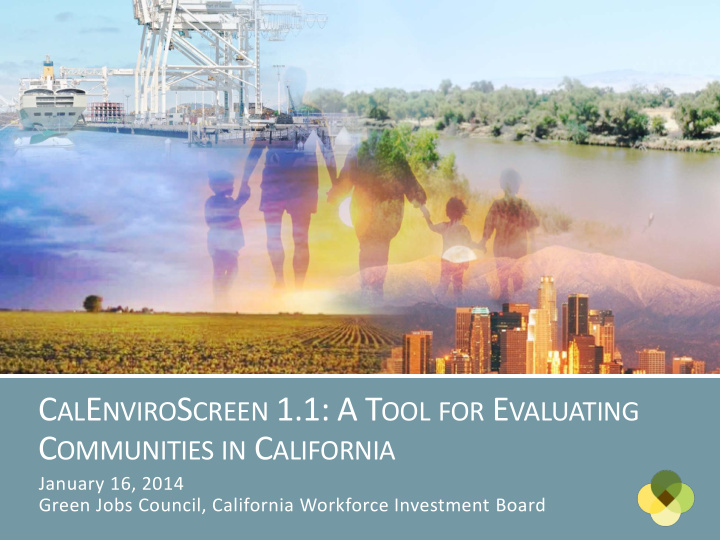



C AL E NVIRO S CREEN 1.1: A T OOL FOR E VALUATING C OMMUNITIES IN C ALIFORNIA January 16, 2014 Green Jobs Council, California Workforce Investment Board
C AL E NVIRO S CREEN 1.1 Prese sents ts a broa oad p pict cture of of the rel elative b burden ens C California co commu mmunities f face f from m en environmental p pollution Identifies 17 s 17 indicator ors of of environmental al a and soc ocioecon onomic c co conditions Provides guidance o on potential uses of of tool ool 2
D EVELOPMENT OF C AL E NVIRO S CREEN 1.1 2008+ December 2010 July 2012 Nine public meetings Framework report of the Cumulative released First CalEnviroScreen Impacts and Cumulative Impacts: draft report released Precautionary Building a Scientific for public comment. Approaches Work Foundation Group. January 2013 Summer-Fall 2012 April and September 2013 Revised draft 12 public workshops, released. academic workshop, 65 written CalEnviroScreen 1.0 1,000 oral and submissions with and 1.1 finalized. written comments. comments. 3
F OCUS OF C AL E NVIRO S CREEN “…exposures, public health or environmental effects from the combined emissions and discharges in a geographic area, including environmental pollution from all sources, whether single or multi-media, routinely, accidentally, or otherwise released. Impacts will take into account sensitive populations and socioeconomic factors, where applicable and to the extent data are available.” -- Working definition of “cumulative impacts” by Cal/EPA Interagency Working Group on Environmental Justice 4
G EOGRAPHICAL U NIT : ZIP C ODE Familiar scale Publicly established Public recognition Not too large Not too small 5
I NDICATORS U SED Pollution Burden Population Characteristics Environmental Sensitive Socioeconomic Exposures Populations Factors Effects PM 2.5 Cleanup sites Prevalence of Poverty (Percent concentrations children and elderly residents below 2x Groundwater poverty level) Ozone Asthma emergency threats (Leaking Educational concentrations underground tanks department visit and cleanups) rate attainment Diesel PM Impaired water Rate of low birth Linguistic isolation emissions bodies weight births Pesticide use Solid waste sites Toxic releases from and facilities facilities Hazardous waste Traffic density facilities and generators 6
C RITERIA FOR I NDICATOR S ELECTION ▪ Provide a good measure of the contribution to the component ▪ Pollution burden indicators should relate to issues that may be actionable by Cal/EPA ▪ Population characteristic indicators should relate to demographic factors that may influence vulnerability to disease ▪ Publicly available ▪ Statewide and location-based information ▪ Good quality data 7
R ELATIVE S CORING OF ZIP C ODES Calculate relative score for each indicator (percentiles) Combine 17 indicators together to calculate overall CalEnviroScreen score CalEnviroScreen scores allow comparison of relative scores between ZIP codes 8
P UBLICLY A VAILABLE R ESULTS CalEnviroScreen Report Maps for individual indicators (small) Description of each indicator Excel spreadsheet “Raw” values and percentiles for each indicator Overall CalEnviroScreen scores Grouped scores (e.g., Top 5 and 10% scoring ZIPs, etc.) Google Earth results (overall; Top 5 & 10%) ArcGIS geodatabase On-line mapping tool (ArcGIS On-Line)
O NLINE TOOL Available at: oehha.ca.gov/ej/ces11.html 10
H IGHEST 10% CalEnviroScreen C AL E NVIRO S CREEN Scores: S CORES Statewide 176 of 1769 ZIP codes in • California. Covers 7.7 million • people (~21% of California’s population). 11
C AL E NVIRO S CREEN CalEnviroScreen S CORES Scores: Statewide All 1769 ZIP codes in • California Each color represents • ~10% of all ZIP codes 12
S OME P OTENTIAL U SES OF T OOL ▪ To aid ongoing planning and decision-making within Cal/EPA ▪ Environmental Justice Small Grant program ▪ Promote greater compliance with environmental laws ▪ Prioritize site-cleanup activities ▪ Strategic Growth Council ▪ First use of CalEnviroScreen outside of Cal/EPA ▪ SB 535 (De Leon, 2012) ▪ Cal/EPA shall identify “disadvantaged communities” for investment opportunities based on geographic, socioeconomic, public health and environmental hazard criteria. 13
C AUTIONS ABOUT THE T OOL ▪ Is not a health risk assessment ▪ Is not a substitute for a CEQA-required cumulative impacts assessment and does not determine whether a specific project’s impacts are significant under CEQA 14
C HANGES IN C AL E NVIRO S CREEN ▪ Adapt tool to census tract scale ▪ Develop drinking water quality indicator ▪ Reach out to interested local governments and others on potential uses of CalEnviroScreen ▪ Solicit suggestions for overall refinement and updating of tool (ongoing) 15
A CKNOWLEDGEMENTS Cal/EPA : OEHHA : Miriam Barcellona Ingenito John Faust Julian Leichty Laura Meehan August Arsenio Mataka George Alexeeff Gina Solomon Komal Bangia Rose Cendak Other thanks: Lara Cushing Cumulative Impacts and Precautionary • Allan Hirsch Approaches Work Group Tamara Kadir Cal/EPA Boards and Departments who provided • Carmen Milanes comments and data; Shankar Prasad California Department of Public Health and the Karen Randles Public Health Institute Robbie Welling Residents and stakeholders who participated in • Walker Wieland our regional workshops; Tara Zagofsky, consultant Lauren Zeise and facilitator, University of California, Davis, Common Ground: Center for Cooperative Solutions T HANK YOU ! Dr. Rachel Morello-Frosch and academic • colleagues at the University of California, Berkeley Academic expert panel who provided comments • at a workshop in September 2012 email: CalEnviroScreen@oehha.ca.gov Graduate students assisting in the project more info: www.oehha.ca.gov/ej •
Recommend
More recommend